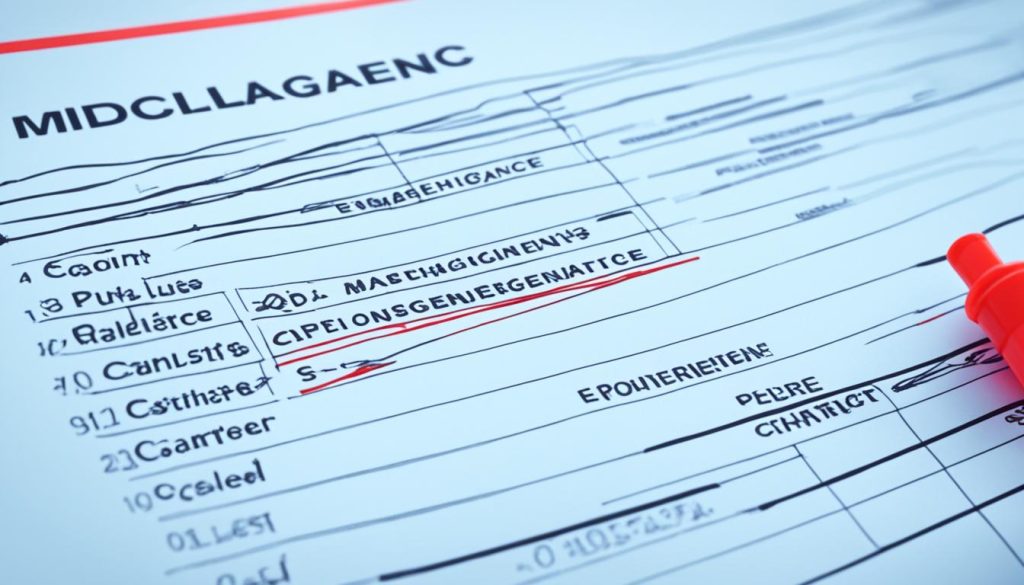Understanding how to prove negligence in medical malpractice cases is key to getting the compensation you deserve1. These cases are complex and need four main elements to win: a doctor-patient relationship, a breach of the standard of care, a direct link between the breach and the injury, and damages2.
To prove medical malpractice, you need strong evidence. This often means hiring experts to show that the care was below standard1. You must document the injury, the doctor’s actions, and the costs and effects on your life. This helps you claim back medical bills, lost wages, and pain and suffering1.
Handling a medical malpractice claim can feel overwhelming, but a skilled lawyer can help a lot1. Janet, Janet & Suggs, LLC is known for their success in these cases, with big wins under Howard A. Janet’s leadership1. If you think you have a case, call them at 1-877-692-3862 for a free talk1.
Key Takeaways
- Medical malpractice cases need four main points: a doctor-patient relationship, a breach of the standard of care, causation, and damages.
- Strong evidence and expert opinions are key to showing poor medical care.
- Having a skilled lawyer can greatly boost your chance of getting full compensation.
- Janet, Janet & Suggs, LLC is an expert in medical malpractice cases, with big wins across the country.
- You can call the firm for a free legal review of your potential medical malpractice claim.
Understanding Medical Malpractice
Medical malpractice happens when doctors or other healthcare workers don’t meet the expected care standards. This can lead to harm to the patient3. It’s hard to prove malpractice because sometimes injuries don’t show up right away. Also, doctors might not always admit their mistakes3. To win a malpractice case, patients must show they had a doctor-patient relationship, the doctor didn’t meet the care standard, the injury was caused by this, and they suffered harm3.
What is Medical Malpractice?
Medical malpractice is when a doctor’s mistake or not doing something they should have leads to harm to the patient3. To prove this, you must show the doctor didn’t follow the usual medical care rules. And that this mistake caused the injury3.
Types of Medical Malpractice
There are many kinds of medical malpractice. These include wrong diagnoses, delayed diagnoses, surgery mistakes, and injuries during birth345. Other examples are doing unnecessary surgery, misreading test results, giving the wrong medicine, not following up with patients, sending patients home too soon, not ordering the right tests, and not acting on test results345.
Malpractice can lead to many problems. These include losing income, needing more medical care, feeling pain, being disfigured, disabled, or suffering mentally3. Getting compensation can help cover these costs and losses5.
Medical malpractice is a complex mix of medicine and law. It needs a skilled malpractice lawyer to handle it well3.
“Medical errors are the third leading cause of death in the United States, following heart disease and cancer.” – Johns Hopkins Study3
Elements of a Medical Malpractice Claim
To win a medical malpractice case, the patient must prove four key things. These are: a doctor-patient relationship, a breach of the standard of care, that the breach caused the injury, and proof of damages678.
Establishing a Doctor-Patient Relationship
The first step is to show there was a doctor-patient relationship. This can be through a formal agreement or the doctor treating the patient. This relationship means the doctor has a legal duty to care for the patient7.
Proving Breach of Duty of Care
The patient must prove the doctor did not meet the standard of care. This means the doctor did not act as a competent provider would in similar situations. Examples include misdiagnosis, wrong treatment, not following up, or not getting informed consent78.
Causation and Damages
The patient must show the doctor’s mistake caused their injury or illness. They also need to prove they suffered losses like medical bills, lost wages, and pain and suffering. Showing this link is key to winning the case78.
Proving these points needs a lot of evidence. This includes medical records, expert opinions, and proof of the patient’s losses7.

Medical malpractice cases are complex. They often need an experienced lawyer to handle. Knowing the main parts of a medical malpractice claim helps patients fight for their rights and get fair compensation7.
Proving Negligence in Medical Malpractice Cases
To win a medical malpractice case, you must show the healthcare provider was negligent. This means they did not follow the usual medical standard of care. Their actions or not doing something led to the patient getting hurt91011.
Sometimes, the rule of res ipsa loquitur applies. This means the injury itself shows the healthcare provider was at fault, even without more proof9. Not getting the patient’s informed consent for a treatment is also seen as negligence11.
To prove medical negligence, you need detailed records and expert opinions. These show the healthcare provider did not meet the standard of care9. Experts in the same field as the defendant are key. They help show what the standard of care is and how the provider did not meet it1011.
| Key Elements of Proving Negligence | Description |
|---|---|
| Duty of Care | The healthcare provider owed a duty of care to the patient. |
| Breach of Duty | The provider’s actions or omissions deviated from the accepted standard of care. |
| Causation | The provider’s negligence directly caused the patient’s injuries or damages. |
| Damages | The patient suffered actual harm or damages as a result of the provider’s negligence. |
By carefully showing the healthcare provider’s mistake and how it caused the patient’s injuries, you can make a strong case for negligence91011.

“Medical malpractice claims are some of the most difficult personal injury cases to prove.”10
Handling medical malpractice cases is complex and needs an experienced lawyer. They can help collect evidence, build a strong case, and get you the compensation you deserve1011.
Evidence Required in Medical Malpractice Cases
Medical Records and Expert Testimony
To win a medical malpractice case, you need strong evidence. This includes the patient’s full medical records. They show what the doctor did and the treatment given12. Experts from the medical field are also key. They help prove the standard of care, show where the doctor fell short, and connect the doctor’s mistake to the patient’s harm12.
Medical records are vital in these cases13. They reveal treatment details, any mistakes by doctors or pharmacists13, and the costs of the mistake13. Other evidence like insurance papers, witness stories, job records, tax info, journals, photos, videos, and texts can also help13.
In places like Pennsylvania, plaintiffs must get experts to say the doctor didn’t meet the standard of care and caused the patient’s injuries12. These experts are key in proving the case by looking at medical records, policies, laws, and test results12.
To prove a medical malpractice case, the link between the injury and the doctor’s mistake must be clear12. Experts often help show this link and explain the medical evidence12.
Building a strong case for medical malpractice takes a detailed look and smart use of evidence. With medical records, expert opinions, and other evidence, plaintiffs can show the doctor was at fault and the damage done1213.
“New Mexico Rules of Evidence § 11-702 sets forth requirements for expert witnesses qualified to testify in civil torts, including medical malpractice cases.”14
Statute of Limitations
The statute of limitations is key in medical malpractice cases. It sets a time limit for patients to sue healthcare providers for negligence. If you miss this deadline, you can’t sue, even if you have a strong case.
Each state has its own deadline for filing a lawsuit. Usually, it’s two to three years after the injury or when you discovered it15. But, this can change if the injury was not clear right away15.
In Florida, you have two years to sue after knowing or should have known about the injury and its possible cause15. But, you can’t sue more than four years after the incident15. Kids have more time to sue, until they turn eight15.
In Ohio, you have one year to sue after the incident16. You must prove the malpractice with evidence16. Minors get more time until they turn 1816.
It’s important to talk to a lawyer quickly if you think you’ve been a victim of medical malpractice15. This way, you make sure you don’t lose your right to sue, even if your case is strong.

In Florida, you have two years to sue for medical malpractice, but four years for ordinary negligence17. There’s also a four-year statute of repose and a seven-year cap for fraud cases, except for minors under eight17.
Florida gives you a 90-day extension for investigations17. If your claim is rejected, you have 60 days to sue after getting a rejection letter17.
Knowing the statute of limitations is key for patients wanting to sue for medical malpractice. Talking to an experienced lawyer is crucial to protect your rights and file your claim on time151617.
Role of a Medical Malpractice Attorney
Dealing with a medical malpractice claim needs an experienced medical malpractice attorney. These lawyers are key in guiding patients through the legal steps. They help from gathering evidence to getting the right compensation18.
Navigating the Legal Process
A good medical malpractice attorney helps patients prove their claim has the right elements. These include duty, breach of duty, causation, and damages19. They work hard to gather important evidence like eyewitness accounts, expert opinions, and medical records18.
Calculating Damages
Attorneys are also key in figuring out the full damages a patient faces. This includes economic damages like medical bills and lost wages, and non-economic damages for pain, suffering, and a lower quality of life19. With a skilled lawyer’s help, patients can get the right compensation for medical mistakes20.
People hurt by medical malpractice in Atlanta should talk to experienced medical malpractice attorneys. These lawyers check if claims are valid and help with legal steps20. They work hard to make sure clients get the right compensation, teaming up with medical experts for strong cases20.
“A skilled medical malpractice attorney guides the patient through the legal steps. This includes gathering evidence, proving the claim, negotiating with insurers, and going to trial if needed.”
| Key Elements of a Medical Malpractice Claim | Description |
|---|---|
| Duty | The legal link between the patient and the healthcare provider. It means the provider must act with the standard of care. |
| Breach of Duty | An act or missing action that goes against the standard of care. This must be proven with expert opinions and evidence. |
| Causation | Showing a direct link between the alleged mistake and the patient’s injuries. This part is often hard. |
| Damages | This includes economic damages (like medical bills and lost wages) and non-economic damages (like pain and suffering). |
Potential Damages in Medical Malpractice Cases
Patients who prove medical malpractice can get different types of damages. These damages are either economic or non-economic in nature21.
Economic and Non-Economic Damages
Economic damages cover the money losses from the malpractice. This includes past and future medical bills, lost wages, and less earning power2122.
Non-economic damages help make up for the personal losses. This includes pain, emotional distress, and loss of life’s joys2122.
The damages given depend on the injury’s severity and its effect on life. Experts may talk about the injuries’ effects21.
Many malpractice cases settle, but winning is hard. The result can change based on expert views21.
Some states limit the damages in malpractice cases. This includes limits on pain and suffering2122.
Survivors of those who died from malpractice can claim damages. This depends on the state’s laws22.
Handling malpractice cases is complex. It involves looking at medical records and filing lawsuits. Getting legal help is often key to getting fair compensation2122.
“Medical malpractice cases often settle, but they are challenging to win, and the outcome can vary depending on expert opinions.”
In summary, damages for medical malpractice can cover both economic and non-economic losses. The type of damages depends on the injury’s severity and its life impact. Getting legal help is important for these complex cases to ensure fair compensation21.
Conclusion
Proving negligence in a medical malpractice case is complex. It needs a deep understanding of the law and a smart plan for gathering and presenting evidence23. Patients must show a doctor-patient relationship, a breach of care standards, a direct link between the breach and their injury, and the injury caused measurable harm23.
With help from a skilled medical malpractice lawyer, patients can tackle the legal hurdles. They can build a strong case and aim for the right compensation for medical negligence23. This way, patients get justice for their injuries and help make healthcare better and safer for everyone24.
Medical malpractice cases need careful attention, strong evidence, and legal experts25. The right legal approach and support can help patients face the challenges. They can get the justice and compensation they deserve for medical negligence232425.
FAQ
What are the key legal elements to prove in a medical malpractice case?
To win a medical malpractice case, the patient must show several things: (1) a doctor-patient relationship was there, (2) the doctor didn’t meet the standard of care, (3) the doctor’s mistake caused the injury, and (4) the injury led to costs, lost wages, and pain.
What is medical malpractice and how does it occur?
Medical malpractice happens when a doctor’s mistake harms a patient. This can be due to wrong diagnoses, surgery errors, or not treating correctly. To prove this, one must show the doctor didn’t follow the usual medical care standards and that this mistake caused the injury.
What are the four key legal elements of a medical malpractice claim?
To win a medical malpractice case, the patient must show: (1) a doctor-patient relationship was there, (2) the doctor didn’t meet the standard of care, (3) the doctor’s mistake caused the injury, and (4) the patient suffered real damages.
How is negligence proven in a medical malpractice case?
Proving negligence in a medical malpractice case means showing the doctor’s mistake caused the injury. This involves showing the doctor didn’t follow the usual medical care standards and that this led to the patient’s harm. Sometimes, the injury’s nature suggests negligence.
What type of evidence is required to prove medical malpractice?
Important evidence includes the patient’s full medical records. These records show what the doctor did and the treatment given. Expert medical opinions are also key. They help explain the usual medical care, show how the doctor fell short, and link the doctor’s mistake to the patient’s injuries and damages.
What is the statute of limitations for filing a medical malpractice lawsuit?
Patients must file a medical malpractice lawsuit within their state’s time limit, usually two to three years after the injury or when it was found. If they miss this deadline, they can’t sue, even if their case is strong.
How can a medical malpractice attorney help?
A good medical malpractice lawyer helps the patient at every step, from gathering evidence to going to trial. They are key in figuring out the patient’s damages, including money losses and pain and suffering.
What types of damages can be recovered in a medical malpractice case?
If a patient proves medical malpractice, they can get back money for medical bills and lost wages. They can also get money for pain, emotional distress, losing out on life, disability, and disfigurement.
Source Links
- How to Prove Medical Malpractice: 4 Things to Know | JJS Justice
- 4 Elements Required to Prove Medical Malpractice
- How Do You Prove Medical Malpractice
- What are the Basic Requirements for a Medical Malpractice Claim?
- Let us Help You With Your Medical Malpractice Lawsuit
- An Introduction to Medical Malpractice in the United States
- Elements of Malpractice | Free Case Evaluation | Ben Crump Law
- What Are the Four Elements of Medical Malpractice
- How To Prove Negligence In A Medical Malpractice Lawsuit
- How to Prove Medical Malpractice
- Proving Fault in Medical Malpractice Cases | Negligence Lawsuits
- Building a Case for Negligence: Key Elements and Evidence Required in Medical Malpractice Litigation Key Elements and Evidence Required in Medical Malpractice Litigation
- 10 Documents To Support Your Medical Malpractice Claim
- Seven Kinds of Evidence You Can Use to Prove Medical Malpractice – Slate Stern Law
- Statute of Limitations in Medical Malpractice Cases
- Ohio Medical Malpractice Law: Statute of Limitations and Burden of Proof
- Florida Medical Malpractice and the Statute of Limitations
- How Do Attorneys Prove Negligence Occurred in a Medical Malpractice Case?
- Medical Malpractice lawyers FAQ | Negligence Attorney | Clifford Law
- Medical Malpractice Lawyers: Navigating Legal Challenges in Healthcare
- Damages In Medical Malpractice Cases
- Damages in Medical Malpractice Lawsuits
- Proving Medical Negligence: Essential Elements in Cases
- Proving Causation in a Malpractice Lawsuit – Berkowitz Hanna
- Burden of Proof in a Medical Malpractice Cases

